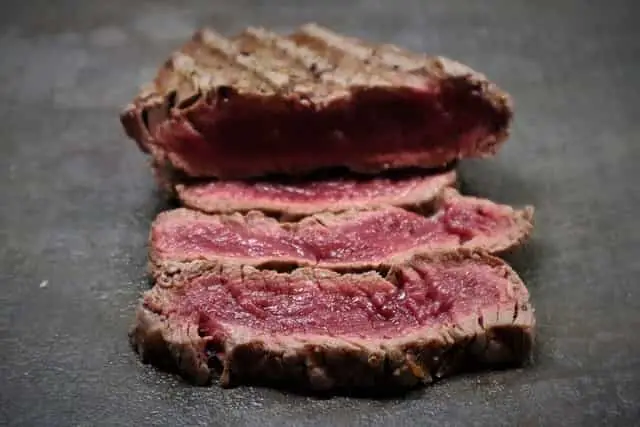Many people enjoy venison because it’s leaner than beef and organic. But can you eat venison rare?
What is the optimal cooking temperature for the best flavor?
Although venison can be eaten rare, it’s best when cooked to an internal temperature of 135°F (62.77°C) to be safe to eat. The most effective way to ensure this temperature has been reached is to check the meat with a meat thermometer before consumption.
In this article, I’ll discuss the risks associated with eating venison rare, what precautions to take when cooking, doneness temperatures for venison, and how rare or well done your venison should be cooked before eating.

Table of Contents
- Is It OK To Eat Rare Venison?
- Is It OK To Eat Pink Deer Meat?
- Can You Eat Undercooked Venison?
- Can You Get Sick From Undercooked Venison?
- How To Handle Venison Properly
- Sources
Is It OK To Eat Rare Venison?
To be safe for consumption, venison should be cooked to an internal temperature of 135°F (62.77°C), which will mean it’s at least medium-rare. Eating rare venison may cause illnesses, such as food poisoning.
Does that mean some people don’t enjoy rare venison? Of course not. I have friends who say “Just sear the outside and throw it on a plate!”
Just like eating a T-bone steak, opinions will vary. Some people say anything over rare is ‘overcooked’ and others prefer a well-done steak.
However, the consensus among the hunting community usually agrees, venison should not be eaten completely rare, but instead medium-rare or medium.
Is It OK To Eat Pink Deer Meat?
Most hunters agree a pink center or medium-rare doneness is best. When venison is cooked correctly, it is a nutritious protein and has been known to lower cholesterol levels.
Properly cooking venison requires a delicate balance. Overcook the meat, and it’s tough and flavorless. Undercook the meat and it may pose some health risks.
Venison is a popular choice for those who enjoy hunting big game and those seeking leaner red meats free of antibiotics and growth hormones found in the factory farm beef industry.
When cooking venison, you shouldn’t necessarily measure its doneness by color but instead by temperature.
Meat thermometers, like the ThermoPro TP03 Digital Instant Read Meat Thermometer from Amazon.com, are inexpensive and can be purchased at most local supermarkets or cooking supply stores, measuring venison rareness is simple.
The ThermoPro TP03 Digital Instant Read Meat Thermometer is a great little device that allows you to check the temperature of your meat on the grill, from the oven, or even on the stovetop.
When your venison steak reaches this point, remove it from heat and transfer it onto a clean plate to avoid contaminating other food with uncooked juices still dripping off the steak. Then let it rest for five minutes before cutting it into pieces and enjoying it!
I personally like to wrap my venison in a piece of tin foil after grilling. This helps retain moisture and flavor while it rests.
Can You Eat Undercooked Venison?
Eating undercooked venison can lead to stomach issues, such as excess gas and in rare cases, food poisoning. Venison should always be cooked, but don’t overcook it!
As mentioned previously, safe internal temperatures are 135°F (62.77°C) for medium-rare. These guidelines help ensure that all harmful bacteria are killed off through proper heat treatment without dissolving out too much flavor in the process–and leaving you with dry venison that is less enjoyable to eat.
You can cook venison like you would any other meat by either frying, baking, roasting, or grilling it.
However, you should always check its internal temperature, regardless of your preferred cooking method.
Electronic instant-read thermometers are ideal because they give an accurate temperature reading when inserted into the thickest part of the meat without constantly checking it while cooking.
Different Cuts of Venison Need To Be Cooked Differently
Different cuts of venison need to be cooked in different ways. For example, venison loin will cook the quickest, mainly because it is a thin piece of meat and so lean.
Cuts of venison from the back legs, which are bone-in, take a lot longer to cook. These cuts can be braised slowly in liquid, such as red wine and broth, for several hours until they become tender enough to eat.
Some unique cuts that require specific cooking temperatures include:
- Racks/Roast: Medium-rare 140°F (57°C)
- Loin Chop: Rare 145°F (62.77°C) & Medium 160°F (71°C)
Can You Get Sick From Undercooked Venison?
Like all red meats, if eaten raw or undercooked you run the risk of contamination or sickness from bacteria. However, when handled and cooked properly, consuming venison actually has very positive health benefits.
How To Handle Venison Properly
After a hard hunt, it’s important to handle your meat with care. Proper game processing is when many hunters say ‘the real work begins. Below are a few tips:
To make sure your meat is safe to eat, follow these steps:
- Consider Freezing the meat for 30 days before cooking it, if possible. Aged meats are safer than fresh meats when consumed rare or medium-rare because any parasites in the food will be killed off by freezing.
- Cook all game at least until an internal temperature of 135°F (62.77°C) has been reached. Cooked venison needs to rest for three minutes after being cooked.
- Always sanitize your cleaning equipment (knives, saws, tables and grinders).
- The best way to minimize this risk is to maintain all food clean and cold. Bacteria can increase rapidly when temperatures rise above 40°F (4.44°C).